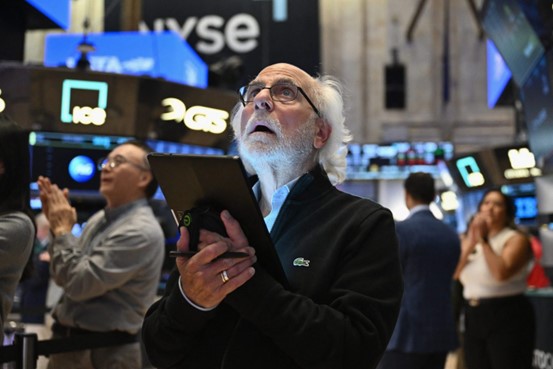
经过华尔街一年多的恳求之后,美联储主席杰罗姆·鲍威尔终于暗示,他将开始降息。上周五,在怀俄明州杰克逊霍尔召开的年度研讨会上,鲍威尔发表了一段备受期待的主题演讲。他表示,他对通胀回落到美联储2%的目标越来越有信心,而且美联储也不再有理由为了控制通胀继续维持高利率。
他说道:“政策调整的时机已经来临。”他指出:“通胀升高风险已经减弱,而且就业下行风险提高。”
在鲍威尔发表演讲之前,7月,美国通胀率降至2.9%的三年最低水平,失业率升高到4.3%,由此触发了一个关键经济衰退指标“萨姆规则”。
鲍威尔强调,两年多来,美联储主要专注于两个职能中稳定物价的部分,现在则更加关注劳动力市场日益增多的风险。他说道:“我们不希望也不欢迎劳动力市场进一步降温。”
鲍威尔表示,未来,即将开始的降息的时机和节奏,将取决于新的数据,但他指出“前进的方向是清晰的”。
他说道:“我们将竭尽全力支持强劲的劳动力市场,同时适度减少政策限制,以进一步稳定物价。”他补充说:“我们有充分的理由认为,美国经济的通胀率将恢复到2%,同时维持强劲的劳动力市场。”
凯投宏观(Capital Economics)副首席北美经济学家史蒂芬·布朗表示,鲍威尔上周五演讲中“明显的鸽派”论调,意味着美联储在9月份的降息幅度可能达到50个基点,远超预期,至少如果8月份失业率进一步升高的话。
然而,布朗认为,7月份失业率升高可能是由于“临时因素”,这意味着除非8月份的就业报告非常糟糕,美联储最有可能在下个月降息25个基点。
投资者是否过于乐观?
GDS财富管理公司(GDS Wealth Management)首席投资官格伦·史密斯也认为,9月份几乎可以确定美联储会降息25个基点。他表示,在鲍威尔发表讲话后,随着美联储开始为经济提供支持,备受期待但经常被忽视的经济“软着陆”似乎终于到来。但美联储计划提供多少支持,仍是个未知数。
史密斯通过电子邮件对《财富》杂志表示:“虽然目前来看,9月份降息已成定局,但更重要的是,这是一次性的降息,还是后续降息周期的开始,这将取决于未来两三个月的经济数据。”
对于下个月之后的未来政策宽松,市场可能过于兴奋。他说道:“我们提醒投资者,历史上股市曾经出现过对降息过度乐观的情况。”
惠誉评级(Fitch Ratings)首席经济学家布莱恩·库尔顿认同这种观点。他通过电子邮件对《财富》杂志表示:“目前似乎没有对于迫在眉睫的经济衰退风险和失业潮的严重担忧,而这些担忧可以成为快速降息的理由。相反,工资增长过高导致通货膨胀居高不下的威胁正在减弱。9月份之后的政策宽松,将是一个循序渐进的过程。”
债券交易商对9月的利率预期,在鲍威尔的新闻发布会后并没有太大变化。芝加哥商品交易所集团(CME Group)的FedWatch工具显示,债券市场已经体现了下个月100%降息的可能性,包括有32.5%的概率降息50个基点,在鲍威尔发表讲话后情况几乎没有变化。
但上周五,股市对鲍威尔的鸽派论调反响积极。道琼斯工业平均指数上涨1.14%,标普500指数和以科技股为主的纳斯达克指数分别上涨了1.15%和1.47%。
另一方面,消费者不会从鲍威尔即将进行的降息中立即受益。银率网(Bankrate)高级行业分析师泰德·罗斯曼等人指出,美联储将逐步降息,这意味着在大多数情况下,消费者借款成本降低的效果需要时间才能显现出来。
他说道:“我们已经看到抵押贷款利率大幅下降。平均30年期固定抵押贷款利率已经从去年10月的约8%,下降到今天的6.62%。但在过去二十年中,这依旧是相对较高的水平。”他补充说:“我们尚未看到信用卡或汽车贷款利率有明显下降。”(财富中文网)
译者:刘进龙
审校:汪皓
经过华尔街一年多的恳求之后,美联储主席杰罗姆·鲍威尔终于暗示,他将开始降息。上周五,在怀俄明州杰克逊霍尔召开的年度研讨会上,鲍威尔发表了一段备受期待的主题演讲。他表示,他对通胀回落到美联储2%的目标越来越有信心,而且美联储也不再有理由为了控制通胀继续维持高利率。
他说道:“政策调整的时机已经来临。”他指出:“通胀升高风险已经减弱,而且就业下行风险提高。”
在鲍威尔发表演讲之前,7月,美国通胀率降至2.9%的三年最低水平,失业率升高到4.3%,由此触发了一个关键经济衰退指标“萨姆规则”。
鲍威尔强调,两年多来,美联储主要专注于两个职能中稳定物价的部分,现在则更加关注劳动力市场日益增多的风险。他说道:“我们不希望也不欢迎劳动力市场进一步降温。”
鲍威尔表示,未来,即将开始的降息的时机和节奏,将取决于新的数据,但他指出“前进的方向是清晰的”。
他说道:“我们将竭尽全力支持强劲的劳动力市场,同时适度减少政策限制,以进一步稳定物价。”他补充说:“我们有充分的理由认为,美国经济的通胀率将恢复到2%,同时维持强劲的劳动力市场。”
凯投宏观(Capital Economics)副首席北美经济学家史蒂芬·布朗表示,鲍威尔上周五演讲中“明显的鸽派”论调,意味着美联储在9月份的降息幅度可能达到50个基点,远超预期,至少如果8月份失业率进一步升高的话。
然而,布朗认为,7月份失业率升高可能是由于“临时因素”,这意味着除非8月份的就业报告非常糟糕,美联储最有可能在下个月降息25个基点。
投资者是否过于乐观?
GDS财富管理公司(GDS Wealth Management)首席投资官格伦·史密斯也认为,9月份几乎可以确定美联储会降息25个基点。他表示,在鲍威尔发表讲话后,随着美联储开始为经济提供支持,备受期待但经常被忽视的经济“软着陆”似乎终于到来。但美联储计划提供多少支持,仍是个未知数。
史密斯通过电子邮件对《财富》杂志表示:“虽然目前来看,9月份降息已成定局,但更重要的是,这是一次性的降息,还是后续降息周期的开始,这将取决于未来两三个月的经济数据。”
对于下个月之后的未来政策宽松,市场可能过于兴奋。他说道:“我们提醒投资者,历史上股市曾经出现过对降息过度乐观的情况。”
惠誉评级(Fitch Ratings)首席经济学家布莱恩·库尔顿认同这种观点。他通过电子邮件对《财富》杂志表示:“目前似乎没有对于迫在眉睫的经济衰退风险和失业潮的严重担忧,而这些担忧可以成为快速降息的理由。相反,工资增长过高导致通货膨胀居高不下的威胁正在减弱。9月份之后的政策宽松,将是一个循序渐进的过程。”
债券交易商对9月的利率预期,在鲍威尔的新闻发布会后并没有太大变化。芝加哥商品交易所集团(CME Group)的FedWatch工具显示,债券市场已经体现了下个月100%降息的可能性,包括有32.5%的概率降息50个基点,在鲍威尔发表讲话后情况几乎没有变化。
但上周五,股市对鲍威尔的鸽派论调反响积极。道琼斯工业平均指数上涨1.14%,标普500指数和以科技股为主的纳斯达克指数分别上涨了1.15%和1.47%。
另一方面,消费者不会从鲍威尔即将进行的降息中立即受益。银率网(Bankrate)高级行业分析师泰德·罗斯曼等人指出,美联储将逐步降息,这意味着在大多数情况下,消费者借款成本降低的效果需要时间才能显现出来。
他说道:“我们已经看到抵押贷款利率大幅下降。平均30年期固定抵押贷款利率已经从去年10月的约8%,下降到今天的6.62%。但在过去二十年中,这依旧是相对较高的水平。”他补充说:“我们尚未看到信用卡或汽车贷款利率有明显下降。”(财富中文网)
译者:刘进龙
审校:汪皓
After more than a year of pleas from Wall Street, Federal Reserve Chair Jerome Powell has finally indicated that he will begin cutting interest rates. In a highly anticipated keynote address at an annual symposium in Jackson Hole, Wyo., on Friday, Powell said that his confidence that inflation is returning to the Fed’s 2% target has grown, and there is no longer a reason to keep rates elevated to fight it.
“The time has come for policy to adjust,” he said, noting that “the upside risks to inflation have diminished and the downside risks to employment have increased.”
Powell’s comments come after inflation fell to a three-year low of 2.9% in July, and the unemployment rate rose to 4.3%, triggering a key recession indicator called the Sahm Rule.
After focusing mainly on the price-stability side of its dual mandate for more than two years, Powell emphasized that the Fed is now more cognizant of rising risks to the labor market. “We do not seek or welcome further cooling in labor market conditions,” he said.
Looking ahead, Powell said that the timing and pace of upcoming interest rate cuts will depend on incoming data, but he noted that “the direction of travel is clear.”
“We will do everything we can to support the strong labor market as we make further progress toward price stability with an appropriate dialing back of policy restraint,” he said, adding “there is good reason to think that the economy will get back to 2% inflation while maintaining a strong labor market.”
Stephen Brown, deputy chief North America economist at Capital Economics, said the “unmistakably dovish” tone in Powell’s on Friday speech is a sign that a larger-than-forecast 50-basis-point interest-rate cut is now possible in September, at least if the unemployment rate rises further in August.
However, Brown argued that the rise in the unemployment rate in July was likely due to “temporary factors,” which means unless August’s jobs report is dismal, a 25-basis-point rate cut next month is the most likely outcome.
Are investors overly optimistic?
Glen Smith, chief investment officer at GDS Wealth Management, also argued that a 25-basis-point rate cut is now all but guaranteed in September. He said that after Powell’s speech, it appears the long-awaited and often-dismissed economic “soft landing” is now finally here, with the Fed coming in to support the economy. But how much support the Fed plans to give is still in question.
“While a September rate cut is essentially a done deal at this point, the more important question is whether this will be a one-and-done rate cut, or if it will be the beginning of a more substantial cutting cycle, and that will be determined by the economic data over the next two to three months,” Smith told Fortune via email.
When it comes to future policy easing after next month, Smith warned, markets may be too excited. “We remind investors that the market has a history of being too optimistic about rate cuts,” he said.
Brian Coulton, Fitch Ratings’ chief economist, echoed that view. “There does not seem to be a serious concern about the risk of an imminent recession and a wave of job losses—i.e., the sort of concerns that could justify rapid rate cuts. Rather it’s about the diminishing threat of elevated wage growth keeping inflation too high,” he told Fortune via email. “The policy easing path post September will be a gradual one.”
Bond traders’ interest rate expectations in September didn’t change much after Powell’s press conference. The bond market was already pricing in 100% odds of a rate cut next month, including a 32.5% chance of an outsize 50-basis-point rate cut, according to CME Group’s FedWatch tool, and little changed after Powell’s speech.
The stock market certainly responded well to Powell’s dovish tone on Friday, however. The Dow Jones Industrial Average rose 1.14%, while the S&P 500 and tech-heavy Nasdaq surged 1.15% and 1.47%, respectively.
Consumers, on the other hand, won’t see an immediate benefit from Powell’s upcoming rate cut. Ted Rossman, senior industry analyst at Bankrate, among others, noted that the Fed will lower interest rates gradually, meaning it will take time to see lower consumer borrowing costs for the most part.
“We’ve already seen a significant drop in mortgage rates. The average 30-year fixed mortgage rate has fallen from about 8% last October to 6.62% today. But that’s still high relative to the past two decades,” he said, adding, “We’ve yet to see a meaningful drop in credit card or auto loan rates.”






